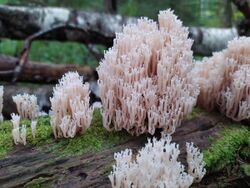Biology:Artomyces pyxidatus
| Artomyces pyxidatus | |
|---|---|

| |
| Scientific classification | |
| Domain: | Eukaryota |
| Kingdom: | Fungi |
| Division: | Basidiomycota |
| Class: | Agaricomycetes |
| Order: | Russulales |
| Family: | Auriscalpiaceae |
| Genus: | Artomyces |
| Species: | A. pyxidatus
|
| Binomial name | |
| Artomyces pyxidatus (Pers.) Jülich (1982)
| |
| Synonyms[1] | |
| Artomyces pyxidatus | |
|---|---|
| Mycological characteristics | |
| smooth hymenium | |
| no distinct cap | |
| hymenium attachment is irregular or not applicable | |
| lacks a stipe | |
| spore print is white | |
| ecology is saprotrophic | |
| edibility: edible | |
Artomyces pyxidatus is a coral fungus that is commonly called crown coral or crown-tipped coral fungus. Its most characteristic feature is the crown-like shape of the tips of its branches. The epithet pyxidatus means "box-like"—a reference to this shape.[2]
Artomyces pyxidatus can be observed throughout Northern Canada during the growing season. In Britain, it was recorded in 2011, almost 116 years after its previous reliable report, a collection made by mycologist Carleton Reale on 20 October 1886. Two subsequent records have been provided in Britain since 2011; one by Yvonne Davidson in Kent in 2018, and one by Cameron Ambler in East Sussex in 2021. Found in Kent in 2023[3] It is widespread but uncommon in Western Europe. They are also widely found in the pine forest of northeastern India, known as the "eight sisters of India."[citation needed]
The fungus produces its hard, coral-like fruiting bodies on decaying wood. The colour ranges from cream to semi-tan.[4] The branches rise in ringlike arrangements resembling a crown.[4] Basidia and basidiospores are produced on the surfaces of the branches.
These fungi are considered edible when raw,[2] but are better cooked. The fungus are known to be served as meal amongst the tribal groups of Northeastern India since time immemorial.[citation needed] It is best served when fried with chopped potatoes.[5] It is usually found in quantities too small to make a meal.[6]
The sesquiterpenes compounds pyxidatols A-C, tsuicoline E and omphadiol have been obtained from the liquid culture of this fungus.[7]
DNA evidence and microscopy indicates that the species is closely related to members of the genera Russula and Lentinellus, as well as Auriscalpium vulgare.[4] Other similar species include Clavulina avellanea, C. cristata, C. divaricata, C. piperata, and C. taxophila.[4]
References
- ↑ "Artomyces pyxidatus (Pers.) Jülich 1982". MycoBank. International Mycological Association. http://www.mycobank.org/MycoTaxo.aspx?Link=T&Rec=110490.
- ↑ 2.0 2.1 "Artomyces pyxidatus refound in Britain". Field Mycology 14 (1): 31–32. 2012. doi:10.1016/j.fldmyc.2012.12.009.
- ↑ Austin, Yvette (16 November 2023). "Ecologist finds rare form of fungus in Kent". BBC. https://www.bbc.co.uk/news/uk-england-kent-67424013.
- ↑ 4.0 4.1 4.2 4.3 Trudell, Steve; Ammirati, Joe (2009) (in en). Mushrooms of the Pacific Northwest. Timber Press Field Guides. Portland, OR: Timber Press. pp. 250–251. ISBN 978-0-88192-935-5. https://books.google.com/books?id=WevHvt6Tr8kC.
- ↑ Meuninck, Jim (2017). Foraging Mushrooms Oregon: Finding, Identifying, and Preparing Edible Wild Mushrooms. Falcon Guides. p. 80. ISBN 978-1-4930-2669-2.
- ↑ Miller Jr., Orson K.; Miller, Hope H. (2006). North American Mushrooms: A Field Guide to Edible and Inedible Fungi. Guilford, CN: FalconGuide. pp. 346. ISBN 978-0-7627-3109-1.
- ↑ "New sesquiterpenes from edible fungus Clavicorona pyxidata". Helvetica Chimica Acta 91 (11): 2174–80. 2008. doi:10.1002/hlca.200890235.
External links
Wikidata ☰ Q2511507 entry
 |

